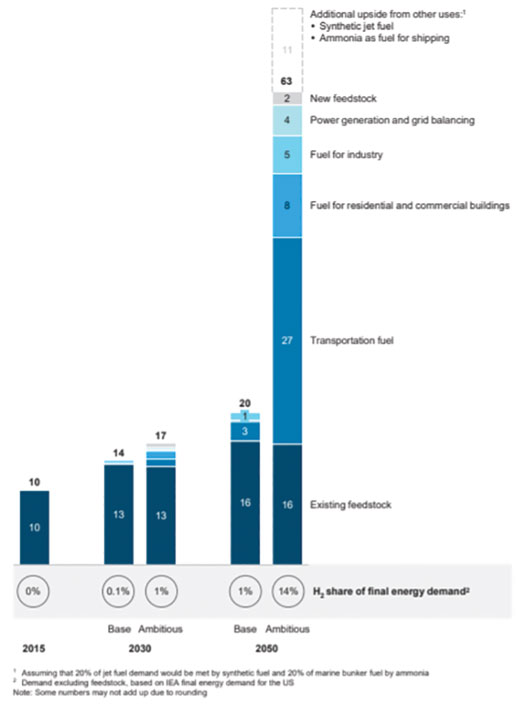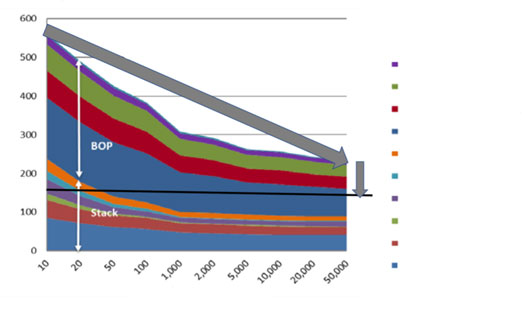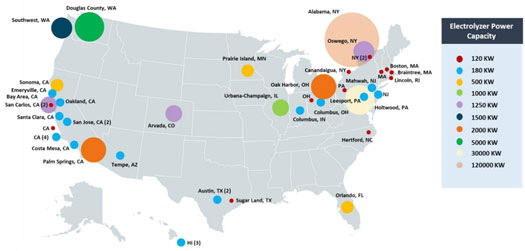Articles
North America sees ripe opportunity for low-carbon H2 production
Regional Report: North America
North America sees ripe opportunity for low-carbon H2 production
A. BLUME, Editor-in-Chief

With its highly developed industrial infrastructure and growing renewable energy sector offering a wealth of opportunities to produce low-carbon H2, North America is ripe to join the H2 frenzy taking place in the Europe and Asia-Pacific regions. Green H2 will find increasing applications in the North American market, particularly the U.S., as production costs decline in the coming years. In the near term, the region is well poised to take advantage of blue H2 projects as a bridge to large-scale green H2 production powered by renewable energy.
This is somewhat in contrast to Europe and Asia-Pacific, where significant climate-change concerns and carbon-reduction efforts have brought green H2 into focus as an immediate and prioritized decarbonization solution. In North America, the market will largely determine how and where low-carbon H2 reaches the U.S. energy system over the following decades.
High H2 growth potential in U.S.
In the U.S., H2 has the potential to play a vital role in balancing the power grid. In combination with renewable energy generation, it can be used to supplement seasonal and large-scale energy storage requirements. H2 can be blended with natural gas to power residential and commercial buildings, and it can help decarbonize the transportation and materials-handling industries with its use in FCEVs.
The report, “Roadmap to a U.S. hydrogen economy,”1 developed by a coalition of major oil and gas, power, automotive, fuel cell and H2 companies and released in October 2020, details how the U.S. can expand its global energy leadership by scaling up activity in the rapidly evolving H2 economy. The Roadmap anticipates that H2 from low-carbon sources could supply roughly 14% of the country’s energy needs by 2050, including hard-to-electrify sectors that are dependent on natural gas, such as high-heat industrial processes and fertilizer manufacturing (FIG. 1).1

Fig. 1. U.S. low-carbon H2 demand potential through 2050, metric MMtpy. Source: “Roadmap to a U.S. hydrogen economy,” McKinsey & Co. and FCHEA.
Furthermore, the Roadmap predicts that H2 alone could reduce U.S. CO2 levels by 16% and its NOX levels by 36% by 2050. However, for these goals to be achieved, the U.S. must realize massive investment in its fledgling green H2 industry in the near term. Greater federal investment is needed to build H2 production and transport infrastructure, as is greater private-sector investment (see this issue’s Editorial Comment for more information).
Also essential are new codes and standards to regulate the expanding H2 supply chain, as well as further research into future large-scale H2 production technologies, such as photoelectrochemical solar water splitting, thermochemical solar water splitting and microbial electrolysis of waste streams.
The U.S. is also studying the blending of up to 15% H2 into the natural gas grid to reduce emissions, such as through the DOE’s HyBlend project. Blends of up to 15% are feasible without significant changes to infrastructure. Blending 20% H2 by 2050 would require approximately 900 TWh of electricity, enabling a doubling of existing renewable generation.
2030 H2 price targets
In line with the need to fast-track research and investment, the U.S. DOE launched its Hydrogen Program Plan in November 2020 and its Hydrogen Energy Earthshot Initiative in June 2021. The Hydrogen Earthshot will help accelerate breakthroughs of more abundant, affordable and reliable clean energy solutions within the decade. Hydrogen Shot also seeks to reduce the cost of low-carbon H2 production, delivery and dispensing by 80%, to $1/kg by 2030, with an interim goal of reaching a price point of $2/kg by 2025. At present, green H2 in the U.S. costs around $5/kg, while blue H2 costs less than $2/kg.
The Program Plan and Earthshot also outline a 2030 targeted price point of $1/kg for H2 for industrial and stationary power generation; $9/kW for low-carbon H2 storage; and a fuel cell system cost of $900/kW for stationary, high-temperature installations with 40,000-hr durability. Furthermore, the plans aim to bring down electrolyzer capital cost to $250/kW–$300/kW with 65% system efficiency and 80,000-hr durability (FIG. 2).2
 Fig. 2. Pathway for reducing electrolyzer cost.
Fig. 2. Pathway for reducing electrolyzer cost.

Fig. 3. Planned and installed PEM electrolyzer capacity in the U.S., as of June 2021. Source: DOE HFTO Program Record.
Achieving these price targets will help meet the Biden–Harris Administration’s goals of a 100% carbon-free electric sector by 2035 and net-zero carbon emissions by 2050.2 The potential for U.S. H2 exports is also being analyzed, with preliminary estimates of the cost of H2 exports from the U.S. to Europe or Japan at $5/kg–$6/kg.
H2 projects
As of June 2021, the U.S. has 182 MW of planned and installed PEM electrolyzer capacity (FIG. 3), according to the DOE. Regionally speaking, the U.S. has two potential H2 hubs: the green-focused West Coast and the industrial-heavy Gulf Coast.
On the West Coast, California’s low-carbon fuel standard is incentivizing research and development for H2 technologies and renewable natural gas (RNG). The California Energy Commission and the California Resources Board have provided direct funding for the development of H2 projects and technologies, putting California in the lead for U.S. H2 development.
In recent and ongoing projects, SoCalGas’ H2Hydrogen Home is the first project in the U.S. to show how green H2 can be used in pure form or as a blend to power homes. The project, which will be built in late 2021 in Downey, California, will encompass solar panels, a battery and an electrolyzer to convert solar energy into green H2. In March 2021, SoCalGas became the largest gas utility in North America to commit to net-zero carbon emissions by 2045. A key component of this goal is to complete five H2 pilot projects by 2025, including H2 Hydrogen Home.
The Los Angeles Department of Water and Power (LADWP) plans to convert its coal-fired Intermountain Power plant in Utah, which feeds the California market, to a mix of 30% electrolyzer-produced H2 and 70% natural gas. The feedstock will rise to 100% H2 over the coming decades. The 840-MW project will help the LADWP meet its 100% renewable energy targets. Also, San Diego Gas & Electric plans to bring two long-duration green H2 storage projects online by 2022. In Nevada, industrial gases supplier Air Liquide is investing $150 MM in a renewable liquid H2 generation plant to produce 30 tpd of low-carbon H2, or enough to supply 40,000 FCEVs, when it opens in 2022.
In California, the long-haul trucking sector is moving toward H2, as the molecule offers a distinct cost advantage over diesel, even without the positive environmental impact. California has the largest total number of FCEVs in the U.S. and one of the largest networks of retail refueling stations in the world, and is expected to host 200 H2 stations by 2025. Shell is building H2 fueling stations in the Los Angeles area to serve the port’s FCEV fueling needs. Also, SoCalGas and SunLine Transit Agency are testing two technologies that will produce H2 from RNG at SunLine Transit Agency’s H2 fueling station in Thousand Palms, California. The research project, called H2 SilverSTARS, will produce green H2 to fuel SunLine’s fleet of 17 H2 fuel cell electric buses (OPENING PHOTO).
On the Gulf Coast, the Houston, Texas area boasts almost 50 steam methane reformers (SMRs), as well as a 420-mi pipeline network to transport H2. The geology of the Gulf Coast region is also favorable for constructing salt-dome caverns for H2 storage. Houston can decarbonize its existing SMR-based infrastructure to create a significant H2 market in the region over the next 2 yr–3 yr, according to think tank Center for Houston’s Future. Texas is also home to a large portion of the U.S.’ wind energy production and has significant solar power resources, making it favorable for the development of green H2 production.
A number of utilities on the West and Gulf Coasts have made pledges to eliminate their carbon emissions by 2050, echoing the net-zero commitments by European and Asian governments and corporations. In line with its own pledge, Gulf Coast utility Entergy plans to build a 1,215-MW power plant near Bridge City, Texas, that is capable of running on a combination of H2 and natural gas on startup in mid-2026. Entergy is also working to blend H2 into natural gas at its power plants, and will convert an underground gas storage facility to hold H2 as part of its long-term decarbonization strategy.
On the East Coast, NextEra Energy’s Florida Power & Light subsidiary plans to build a $65-MM pilot plant in Florida to produce green H2 from a 20-MW electrolyzer powered by solar energy, with startup slated for 2023. The H2 produced would replace a portion of the natural gas that is presently used at the 1.75-GW Okeechobee power plant. If green H2 becomes economic, Florida Power & Light may retrofit some of its natural gas facilities to run wholly or partially on H2.
In the Rocky Mountain region, Dominion Energy is developing several pilot projects to blend H2 into its gas distribution system and use H2 in the generation of clean electricity, renewable storage, transportation and manufacturing. In the first project, Dominion will blend 5% H2 in a test system at its training facility in Utah before blending it into a larger system that serves more than 1 MM gas utility customers. The company has proposed a similar project for North Carolina.
RenewH2 plans to produce, store and deliver 300 tpd of blue H2 by reforming biogenic methane from SMR at its Wyoming facility from 2023. Hyzon Motors, which will develop ultra-heavy-duty liquid H2-fueled trucks, has signed an MOU with RenewH2 to collaborate on H2 supply and demand logistics.
In the Midwest, New Fortress Energy is working with GE and Black & Veatch to introduce H2 into the natural gas turbines at the 485-MW Long Ridge Energy Terminal power plant in Hannibal, Ohio. The project is slated to begin producing CO2-free power by the end of 2021. It will be the first purpose-built H2-burning power plant in North America. The Long Ridge plant’s combustion turbine will initially burn from 15 vol%–20 vol% H2 in the gas stream and transition to burning 100 vol% green H2 over the next 10 yr. Mitsubishi Power and Bakken Energy are considering a redevelopment of Basin Electric Power Cooperative’s Dakota Gasification plant near Belulah, North Dakota, to produce blue H2. The coal gasification plant, which has been struggling due to low commodity prices in recent years, already captures 2 metric MMtpy of CO2. The companies are presently conducting due diligence for the proposed project.
Meanwhile, Nikola is investing $50 MM for a 20% equity interest in a blue H2 project being developed in West Terre Haute, Indiana. The project will use solid waste byproducts, such as petroleum coke combined with biomass, to produce blue H2 for transportation fuel and baseload power generation while capturing CO2 emissions for permanent underground sequestration. Once completed, the project is expected to be one of the largest carbon-capture and clean H2 production projects in the U.S. The H2 will be used to fuel Nikola’s zero-emissions trucks.
Additionally, Enel Green Power, through its North American renewable subsidiary Enel Green Power North America, and Maire Tecnimont, through its subsidiary NextChem, are building a plant to produce green H2 via electrolysis at an undisclosed location in the U.S. The plant, which will become operational in 2023, will convert solar energy from an EGPNA installation into green H2 for use at a biorefinery.
Canada eyes H2 for net-zero targets
Canada produces an estimated 3 metric MMtpy of H2 at present, with the majority of this as gray H2 for industrial use. Canada’s federal government released its Hydrogen Strategy for Canada in December 2020 as part of its national plan to become carbon neutral by 2050.3 Prime Minister Justin Trudeau has also pledged to cut carbon emissions 45% below 2005 levels by 2030. The country plans to lay the foundation for its H2 economy through 2025, including the development of new H2 supply and distribution infrastructure to support the deployment of early H2 projects in mature applications while simultaneously supporting emerging applications for H2.
From 2025–2030, Canada will work to diversify its H2 market into applications such as FCEV cars, buses and heavy-duty trucks, as well as H2/natural gas blending for industrial and chemical feedstock in regional hubs. As renewables are increasingly introduced into the electricity grid, pilot plants to produce H2 for use in utility-scale energy storage will be required. In the 2030–2050 time frame, Canada will capitalize on its H2 supply and distribution infrastructure and realize the full benefits of its growing H2 economy.
According to the government’s estimated potential adoption rates for hydrogen by 2050, H2 could account for 31% of secondary energy use in Canada by 2050 under a “transformative” scenario, assuming net-zero targets are reached and economic and population growth are offset by efficiency improvements resulting in consistent energy consumption over time. This represents just over 20 metric MMtpy of H2 demand in 2050 (FIG. 4).3

Fig. 4. Canada low-carbon H2 demand potential through 2050. Source: Government of Canada.
A more conservative “incremental” scenario, based on less aggressive policy assumptions, shows opportunity for 8.3 metric MMtpy of H2 demand by 2050; however, this scenario is not consistent with meeting net-zero targets in 2050 (FIG. 4).3 Ultimately, the market will decide where best to deploy H2 when greater supply becomes available domestically. The main drivers for H2 market development will be cost competitiveness compared to alternative energy sources and decarbonization potential.3
According to a report from Alberta’s Transition Accelerator, in Canadian provinces that have ample low-carbon electricity from hydropower, nuclear or renewables, electrolysis can produce green H2 for $2.50/kg–$5/kg. In provinces with low-cost natural gas and geology suitable for permanently sequestering CO2, blue H2 can be produced at a cost of $1.50–$2/kg. It is anticipated that by 2030, green H2 will be cost-competitive in Canada as a result of lower renewable energy costs and the scaling up of electrolyzer technology.
H2 projects
In Canada, utilities are field testing green H2 blends with natural gas ahead of the 2021–2022 heating season for the Ontario and Alberta residential markets. A Québec pilot project will employ H2 to extract ethanol and methanol from landfill sites. Also, British Columbia and Québec have already begun deploying H2 fueling infrastructure to support FCEV mobility. Furthermore, the country’s Hydrogen Strategy acknowledges that significant renewable resources exist to generate green H2, including existing hydroelectric generation in British Columbia, Québec, Manitoba, and Newfoundland.
The government has also singled out Canada’s vast natural gas reserves, primarily in Alberta, as a main fuel source for blue H2 production to exploit inherent competitive advantages. In Alberta, Air Products is building a $1.1-B complex in Edmonton to produce blue H2 and capture 95% of its carbon emissions. When it opens in 2024, the Net-Zero Hydrogen Energy Complex will be the first of its kind in Canada. Air Products will also build an H2 liquefaction facility to supply industrial customers and commercial FCEV fleets, as well as an H2-based power plant.
Canada’s Suncor Energy will partner with utility ATCO Ltd. to develop a blue H2 project near Fort Saskatchewan, Alberta. The project would produce more than 300,000 metric tpy of low-carbon H2 by capturing carbon emissions from oilsands production. An FID on the project is expected in 2024, with operations projected to start by 2028 if the project is sanctioned. Around 65% of the H2 produced would be used at Suncor’s Edmonton refinery, while another 20% could be used in the Alberta natural gas grid.
In Québec, Air Liquide inaugurated the world’s largest PEM electrolyzer in Bécancour in January 2021. The 20-MW electrolyzer, which is capable of producing up to 8.2 metric tpd of H2, increased the capacity of Air Liquide’s Bécancour H2 production complex by 50%.
Also in Bécancour, Canada’s H2V Energies is building a green H2 plant that will commence production in 2022. The Alpha plant, to be constructed in the Bécancour Waterfront Industrial Park, will deploy a new industrial plasma gasification technology for converting raw residual biomass material into syngas to produce around 49,000 metric tpy of green H2 without electrolysis.
Meanwhile, the green H2 division of Thyssenkrupp Uhde Chlorine Engineers was awarded a contract to carry out the installation of an 88-MW electrolysis plant for Hydro-Québec, an energy firm backed by the provincial government. The electricity for the plant, to be built in Varennes, will come from hydropower. The project will generate 11,100 metric tpy of green H2 on startup in late 2023.
Evolugen, the Canadian operating business of Brookfield Renewable, and Gazifère, an Enbridge company, are collaborating on a $90-MM project to advance the development and use of green H2, and have announced plans to build and operate a 20-MW water electrolysis plant in the Outaouais region of Québec. An estimated capacity of approximately 425,000 GJ of green H2 will be produced for injection into Gazifère’s distribution network.
In British Columbia, Renewable Hydrogen Canada (RH2C) plans to produce green H2 through water electrolysis powered by wind and hydropower. RH2C’s first project, Sundance Hydrogen, is a JV among RH2C, FortisBC and Macquarie Green Investment Group. The project will feature a $200-MM green H2 plant with a dedicated wind farm. Utility FortisBC will be the offtaker for the plant’s production of 60 metric tpd of H2, which will help it increase the renewable content of its natural gas to 15%, as per a provincial mandate.
In Ontario, Enbridge and Hydrogenics were selected by the Independent Electricity System Operator for Ontario for a grid energy storage project. The project will deliver 2 MW of storage capacity and be located in the greater Toronto area. Hydrogenics will supply the facility’s next-generation PEM electrolyzers and is partnering with Enbridge to develop, build and operate the energy storage facility.
Furthermore, Enbridge Gas and Cummins are undertaking a $5.2-MM project to pilot the blending of renewable H2 produced at the Markham, Ontario power-to-gas facility into a portion of the existing natural gas network serving about 3,600 customers. The success of the project in 2021 will support Enbridge Gas in pursuing additional and larger-scale H2 blending activities in other parts of its distribution system.
Ontario’s nuclear industry also has the potential to work synergistically with H2 by using off-peak electricity for electrolysis or by using excess steam from nuclear reactors (including future small modular reactors) to improve electrolyzer efficiency.
Regional outlook
North America is joining Europe and Asia in starting up blue and green H2 projects and building out H2 infrastructure. The potential for H2 use in power generation, industrial heating and as an industrial feedstock in the U.S. and Canada is high.
Near-term opportunity exists in using blue H2</sub+> to reduce feedstock emissions in refining and ammonia manufacturing. For green H2 to be competitive at a large scale, substantial decreases in production and storage costs will be necessary over the next decade to bring down the price of green H2 to $2/kg.
Literature cited
1 “Roadmap to a U.S. hydrogen economy,” McKinsey & Co. and Fuel Cell & Hydrogen Energy Association (FCHEA), October 5, 2020, Online: https://www.fchea.org/us-hydrogen-study
2 Satyapal, S., “2021 AMR plenary session,” U.S. DOE, Office of Energy Efficiency and Renewable Energy, Hydrogen and Fuel Cell Technologies Office, June 7, 2021.
3 “Hydrogen strategy for Canada: Seizing the opportunities for hydrogen,” Government of Canada, December 2020.
Opening photo: SoCalGas and SunLine Transit Agency’s joint research project, H2 SilverSTARS, will produce green H2 to fuel SunLine’s fleet of 17 H2 fuel cell electric buses. Photo: SoCalGas.
Fig. 1. U.S. low-carbon H2 demand potential through 2050, metric MMtpy. Source: “Roadmap to a U.S. hydrogen economy,” McKinsey & Co. and FCHEA.
Fig. 2. Pathway for reducing electrolyzer cost.
Fig. 3. Planned and installed PEM electrolyzer capacity in the U.S., as of June 2021. Source: DOE HFTO Program Record.
Fig. 4. Canada low-carbon H2 demand potential through 2050. Source: Government of Canada.

